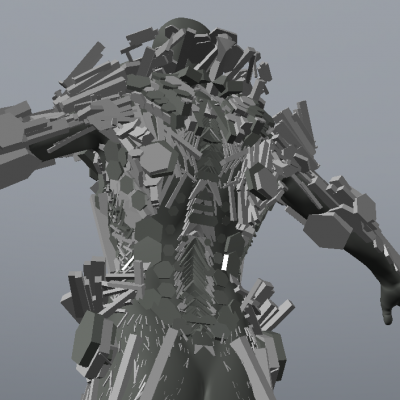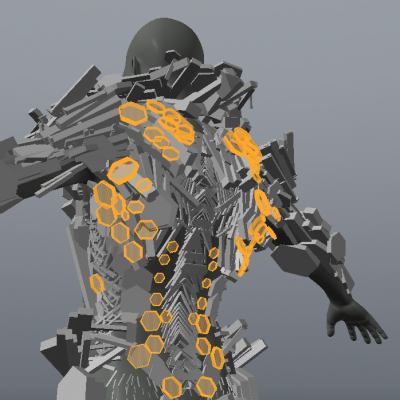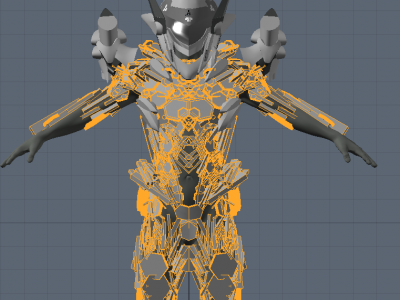 Approved for use in RP! Approved for use in RP!  |
Structol Substrate
| Listen while reading? |
|---|
| ♫ Asa Chang – “ Aku no Hana” KTG/OSAONE edit, (OVERstep) ver. |
Essentially a synthetic 'flesh' acting as a self-healing motherboard, mounting chassis, musculature, nervous-system, circulatory system, filtration systems and synthetic smart skin, giving units performance and characteristics similar to organisms without being organic in its construction.
Lazarus Consortium LZ-SSA Structol Substrate
Structol Substrate is a replacement for the Structral Layering System and associated mounting mesh, armour mesh and integrating basic gravitational and casimir manipulation (as seen on the AMX-101/2) as a baseline for all future Lazarus units employing the substrate.
Importantly, it can be retrofitted to existing equipment to improve overall efficiency and reliability.
History & Background
 As late as –, Lorath engineers are still relying on the structural layering system to act as a motherboard of sorts for their units. Integrating wiring, cooling, basic kinematics (movement) and gravitational manipulation, the SLS's primary purpose was to integrate components in a way which was standardised, allowing them to be rapidly swapped between sorties.
As late as –, Lorath engineers are still relying on the structural layering system to act as a motherboard of sorts for their units. Integrating wiring, cooling, basic kinematics (movement) and gravitational manipulation, the SLS's primary purpose was to integrate components in a way which was standardised, allowing them to be rapidly swapped between sorties.
The SLS saw great success with the Winter, Hawk Fighter-Bomber and a variety of other Lorath combat units but unfortunately ran into huge cost, manufacturing and logistical hurdles when applied on a starship grade scale. In addition, it placed incredible new stresses on Lorath engineers and deck mechanics due to the tedious nature of its design. This extra work necessitated more engineers, snowballing into greater logistical problems and mistakes.
Acting as a direct replacement to the SLS, the Consortium developed Structol Substrate or SSA. As the name would suggest, SSA is based on structol, a self-growing self-organising and self-healing programmable material with semi-organic properties which can be grown rather than built (leading to huge obvious cost savings).
Very importantly however, it could heal whatever ruptured linkages were between key primary systems (saving hours of tedious diagnostic when the components themselves were fine) and identify when components were actually damaged (and not just the linkages). As a result, this would free up deck mechanics and engineers reducing turn-around times and enhancing ship readiness and logistical problems since now engineers were only dealing with primary component failure/replacement cycling and loadout fitting.
In addition, if a ship has the pools needed to grow the substrate and a qualified engineer as well as the 3D printing equipment used to fabricate new components, new units can be built in the field to replace those lost in days or even hours.
An unforeseen development arising naturally from the way in which structol worked was the capacity for self-optimisation - searching for bottlenecks in components and eliminating them where possible. In this way, implementing SSA can breathe new life into older equipment.
About the Structol Substrate
 The SSA itself is a flexible self-healing motherboard, acting as a combined circulatory system, central nervous-system, musculature and filtration system (not unlike the heart and lungs, blood-vessels, nerves and muscles of a person).
The SSA itself is a flexible self-healing motherboard, acting as a combined circulatory system, central nervous-system, musculature and filtration system (not unlike the heart and lungs, blood-vessels, nerves and muscles of a person).
It works by replacing the wiring, piping, pumps, circuitry, motors, capacitors, cooling systems, internal sensors, damage-control systems, communications equipment and external apparatus of field-generators and engine systems with the substrate itself.
Of particular note are the transmission-fibres which act as combined arteries and nerves to exchange electricity, data, light (for photonics), particulates, liquids and gasses between components. There is no centralised pump or heart, with the fibres relying instead upon Delta-pressure, electrostatic induction and kinetic massage. Plasma, positrons, packets and even – can be moved through the use of permanent penning-traps as so the materials do not contact the surface-walls of the transmission fibre and sub-dermal insulation to protect other fibres and systems. These fibres react preemptively anticipating rupturing (and sealing accordingly) and are designed to vent ruptures away from primary systems in order to prevent procedurally caused catastrophic damage.
Unusually, these fibres are also capable of filtration of particulates up to 10 nanometers and can feature sub-component 'blocks' which act like the liver or kidneys of a person to filter specific chemical substances, allowing for the integration of biochemical systems into the substrate (such as pilot).
These sub-component blocks can be used to enhance primary systems (such as computers, filters, transformers, capacitors and storage bladders – or any system relying on them). In doing so, stress is reduced and bottlenecks are overcome on primary components, measurably improving their responsiveness, capacity, reliability, stability and operational life-span. As the unit is pushed to its limits, new bottlenecks are identified which the substrate responds to accordingly. This gives a unit the capacity for improvement depending on how hard it is pushed by its user. In the event of a primary systems failure, these sub-components double in as emergency backups, preventing catastrophic systems damage caused by component failure.
The substrate also allows very precise control over where power or material is going at any given moment. This means the unit using the substrate does not need to be deactivated to be serviced. Instead, specific systems are singled out and powered down or into acceptable ranges. This has the added advantage of allowing hot-swappability with primary components, even in the field of combat. Combined with the substrate's learning capacity, it can incorporate components of foreign manufacture recovered from downed opponents at the pilot's discretion – authoring its own drivers. Granted, the device will not operate as efficiently though its performance will improve through time as the drivers improve. Such independence of core components allows a unit employing the substrate to operate deep inside enemy territory for extended campaigns beyond the reach of classical logistics.
In addition, any unit fielding the substrate can be automated using ARIA AI standard, RICE derived operating systems3 or the–, receiving instructions via quantum modem.
Operational Requirements
 Being composed of structol, the energetic requirements of the substrate itself alone are quite low. In this sense, it can operate independently of a main generator though it would be dragging the units primary components along as dead-weights (not unlike a being with unpowered cybernetic augmentation). To power itself, the substrate relies on euralis quasicrystalline pickups which convert background radiance into useful electricity (for example, from a sun or the magnetic flux of a planetoid) for its base operational needs. During repair or growth however, the substrate requires access to raw-structol (which in turn, is produced from matter – usually water, ore and organic components like soil).
Being composed of structol, the energetic requirements of the substrate itself alone are quite low. In this sense, it can operate independently of a main generator though it would be dragging the units primary components along as dead-weights (not unlike a being with unpowered cybernetic augmentation). To power itself, the substrate relies on euralis quasicrystalline pickups which convert background radiance into useful electricity (for example, from a sun or the magnetic flux of a planetoid) for its base operational needs. During repair or growth however, the substrate requires access to raw-structol (which in turn, is produced from matter – usually water, ore and organic components like soil).
This essentially means that even if primary components are shot, basic computation, sensor reading, complex movement (such as walking), basic low-capacity gravitational propulsion, casimir long-distance propulsion, communications and life-support remain active.
In this 'silent running' profile, the unit produces very little in the way of detectable emissions and like SLS, can move its radiant profile away from itself using casimir transfer.
Physical Description
At a glance, the substrate resembles a geometric lensing of organic musculature with bars, rods and simple shapes replacing organic components. When light is shone upon it, differences in reflectiveness and transparency illuminate the polished gel-like interior which resembles a city or growth of synthetic fungi. When struck or anticipating a strike, the substrate loses its glossy oily quality and hardens. In some contexts, it acts like a gel or fibre, others a non-newtonian fluid.
If cut or nicked, the substrate usually oozes raw structol which is used to clot the gap. Raw structol is either black (with almost no viscosity) or white (and highly viscous) fluid with a faint synthetic plastic metallic scent similar to that of paint-thinner or aluminium shavings. Tasted, it is inoffensive to the senses with a thick flavour of weak copper masked by simple carbohydrates (like sugar) with an overtone 'not unlike humanoid mucus' despite its primarily synthetic nature.
Components
Sub-Dermal Layer
A multifunction component making up the bulk of the substrate. Sub-dermal provides insulation, emission recovery, emission masking, containment (not unlike how fat cells hold water) and acts as the primary musculature of the substrate. Used properly, the sub-dermal layer can withstand the low pressure regions (and briefly some of the high-pressure regions) of a gas-giant.
Epidermal Layer
The outer-most layer, the epidermis is designed to deal with possible threats. Often growing over armour plating laid ontop of the sub-dermal layer as well as the sub-dermal layer itself, the epidermis can perform noteworthy feats of insulation, absorption and reflection of electromagnetism. Anticipating kinetic strike, it hardens into a thin ablative plating designed to shatter (which then heals after distributing the energy away from what is beneath it). A secondary layer beneath the external epidermis contains variable-direction thermal insulating composite, made up of organic polymers, borates and thralls quasicrystals. This material can be 'tuned' to let heat only exit or only enter like a one-way door of sorts and is able to withstand up to 4000 degrees celcius without assistance from onboard casimir cooling. This layer can be thickened depending on the mission profile.
Sub-elements
The extensions created by the substrate which enhance primary systems operation and anticipate changes in demands - removing bottle-necks while acting as backup systems.
Transmission fibre
Serving as the circulatory and central-nervous-system of the substrate. Connected to components. Self-routing, self-healing, self-managing and self-optimising.
Shock Vane
Essentially a horn of gravitic centrifuges spun around a convex field amplifier. Acts as a high-power transmitter and receiver, able to generate, control and detect the powerful electromagnetic fields used to generate barriers and spacial nesting systems. Doubles as a sensor and actuator for gravitic interaction. Must be extended to full length for full effect. Based on the engine-prongs of the Maras. These centrifuges cannot be grown by the substrate itself and are classed as a 'primary component'.
Pulse-Channels
A concave version of the shock-vane, centred around managing to act as a sort of engine nozzle, air-intake of cooling system. Appear as long carved strips which are usually hidden. Potentially weaponisable up close. Often, shock-vanes withdraw into these channels, disappearing beneath the epidermis.
Solenoid
A special combination of pulse-channel and transmission fibre used to push high-power weaponised outputs from a weapons-system. It does not act as the weapons-system itself but is used in propelling the round, be it solid (not unlike a railgun or pressure-harpoon), particle (plasma), packet or – from a projection source inside the unit. They are commonly fitted into hands.
Interlock
A special plug which allows transmission fibre from two substrates to exchange material, charge or information (ideal for providing a buff).
Raw structol
A liquid state of structol generated by the substrate which is able to act as scar-tissue or raw materials in the construction of new components. Its rate of production is limited and requires access to raw materials either onboard the unit or in the operating environment. In suffering catastrophic damage, raw structol can be seen 'bleeding' as a thick viscous glossy black or white liquid. Commonly stored in reserve inside the sub-dermal layer.